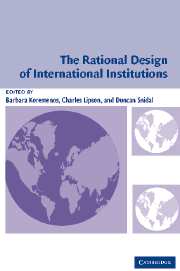Book contents
- Frontmatter
- Contents
- Contributors
- Abstracts
- Title Page
- The Rational Design of International Institutions
- Trust Building, Trust Breaking: The Dilemma of NATO Enlargement
- The Optimal Design of International Trade Institutions: Uncertainty and Escape
- Most-Favored-Nation Clauses and Clustered Negotiations
- Situation Structure and Institutional Design: Reciprocity, Coercion, and Exchange
- Private Justice in a Global Economy: From Litigation to Arbitration
- Multilateralizing Trade and Payments in Postwar Europe
- The Institutional Features of the Prisoners of War Treaties
- Institutions for Flying: How States Built a Market in International Aviation Services
- Driving with the Rearview Mirror: On the Rational Science of Institutional Design
- Rational Design: Looking Back to Move Forward
- References
The Optimal Design of International Trade Institutions: Uncertainty and Escape
Published online by Cambridge University Press: 28 October 2009
- Frontmatter
- Contents
- Contributors
- Abstracts
- Title Page
- The Rational Design of International Institutions
- Trust Building, Trust Breaking: The Dilemma of NATO Enlargement
- The Optimal Design of International Trade Institutions: Uncertainty and Escape
- Most-Favored-Nation Clauses and Clustered Negotiations
- Situation Structure and Institutional Design: Reciprocity, Coercion, and Exchange
- Private Justice in a Global Economy: From Litigation to Arbitration
- Multilateralizing Trade and Payments in Postwar Europe
- The Institutional Features of the Prisoners of War Treaties
- Institutions for Flying: How States Built a Market in International Aviation Services
- Driving with the Rearview Mirror: On the Rational Science of Institutional Design
- Rational Design: Looking Back to Move Forward
- References
Summary
International institutions differ greatly in their forms; the number of states included, the decision-making mechanisms, the range of issues covered, the degree of centralized control, and the extent of flexibility within them all vary substantially from one institution to the next. What accounts for such variation? In this article, as part of the larger Rational Design project on the design of international institutions, we claim that such variation can be accounted for as part of the rational, self-interested behavior of states. We show that at least one important aspect of institutional design can be explained as a rational response of states to their environment.
Almost all international trade agreements include some form of “safeguard” clause, which allows countries to escape the obligations agreed to in the negotiations. On the one hand, such escape clauses are likely to erode both the credibility and the trade liberalizing effect of international trade agreements. On the other hand, they increase the flexibility of the agreement by adding some discretion for national policymakers. The first question we address is the institutional design issue that escape clauses raise: when is such increased flexibility rationally optimal for states making international trade agreements? The answer to this question hinges on the costs of using escape clauses and retaining the overall agreement compared with not using them and abrogating the agreement.
Our second question concerns the effects of different institutional designs.
- Type
- Chapter
- Information
- The Rational Design of International Institutions , pp. 69 - 98Publisher: Cambridge University PressPrint publication year: 2003
- 1
- Cited by



